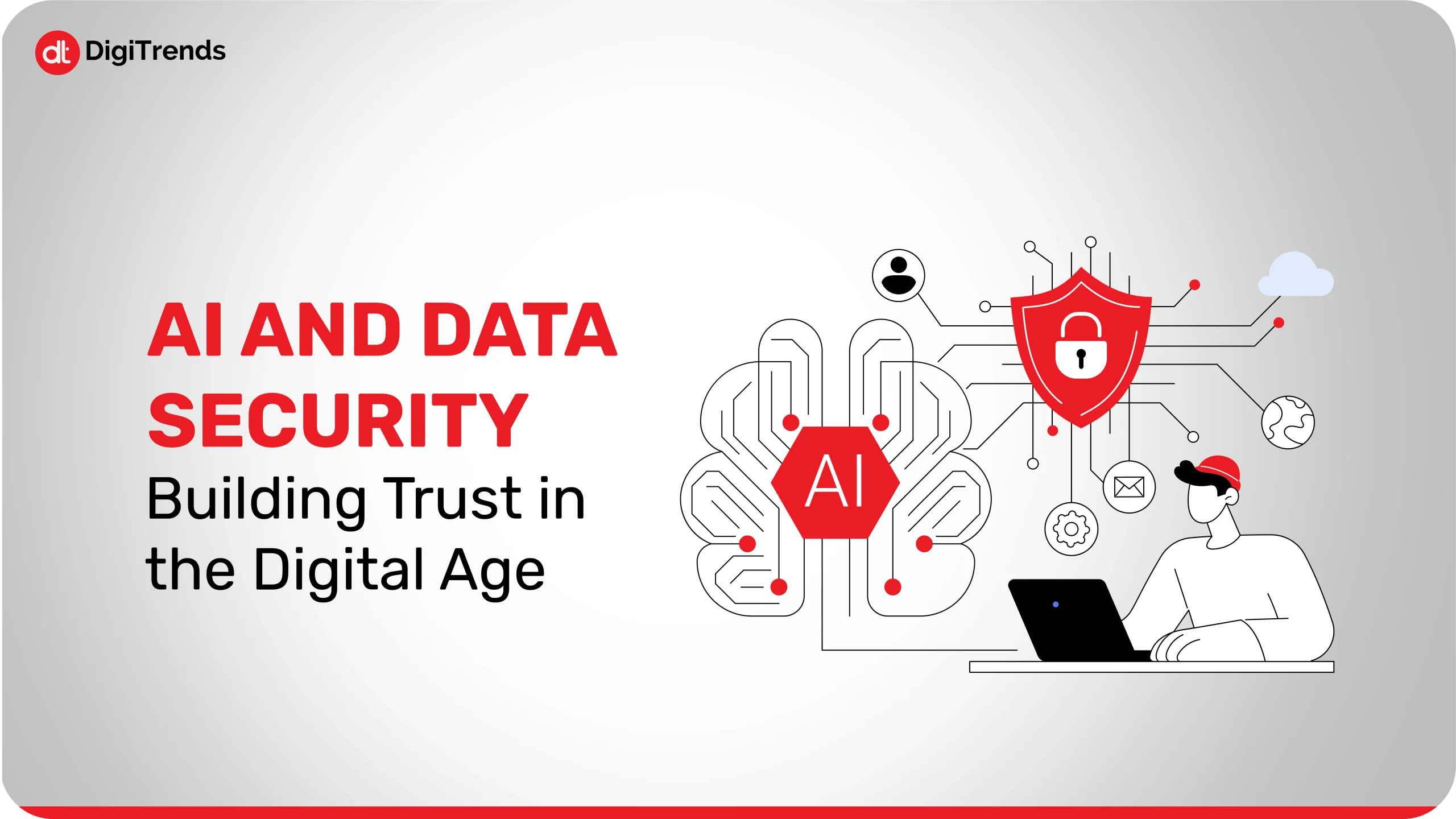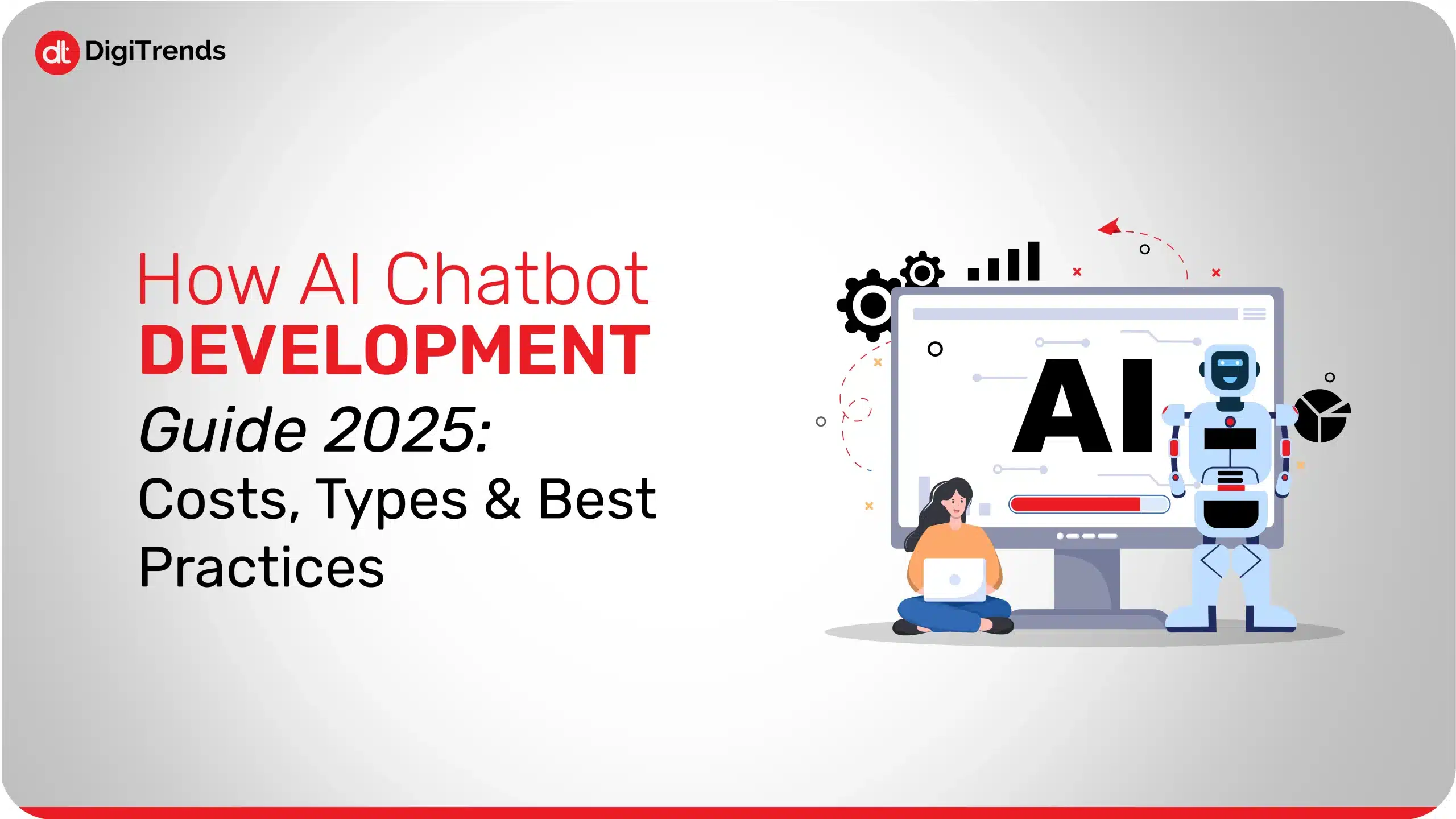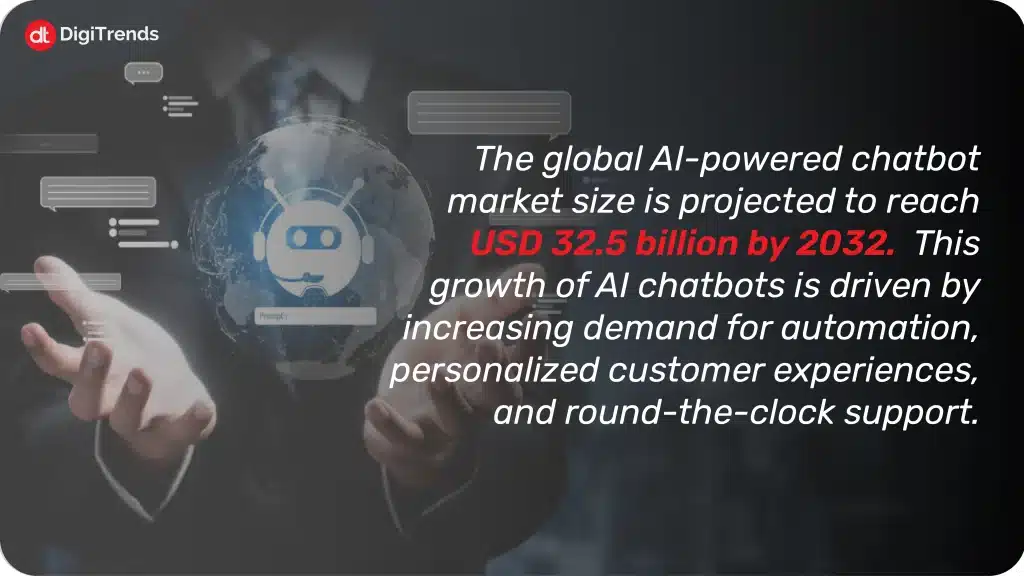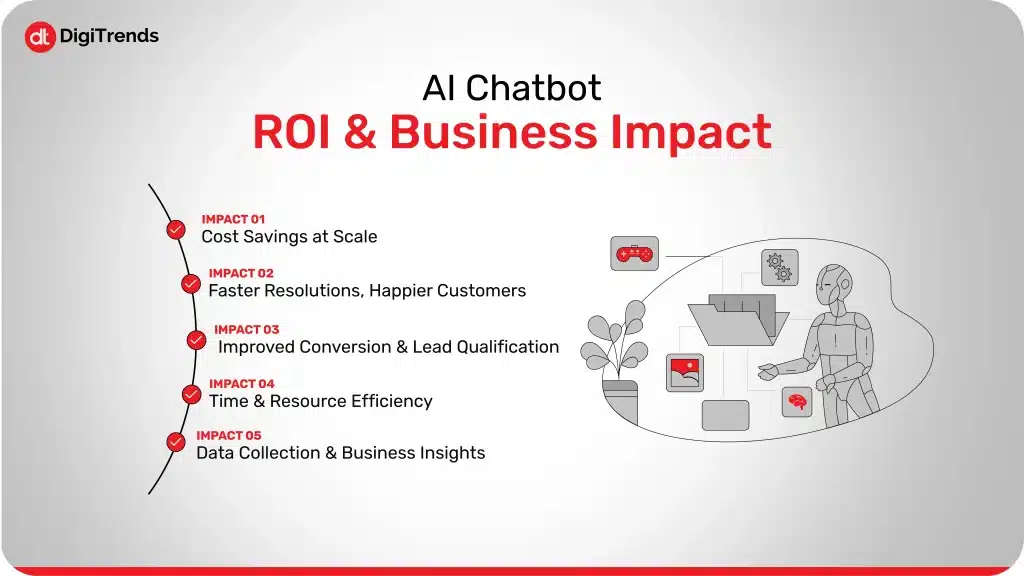
AI and Data Security: Building Trust in the Digital Age
Explore why data security and AI matter, the challenges of securing AI-driven environments, and how to maintain a balance.
Continue Reading
Do you also struggle with managing endless messages from curious customers? Tired of answering the same questions, everyday?
Or are you considering hiring yet another customer support representative just to keep up with the messages and queries?
If this sounds familiar, you’re not alone. As businesses grow, so do customer expectations. Customers now demand fast, accurate, and 24/7 responses, and that’s something even the best companies struggle to deliver at scale.
That’s where AI chatbots come in!
Now, AI chatbots are smarter, more responsive, and more human-like than they used to be. Artificial intelligence chatbots can easily handle FAQs, book appointments, and guide users through entire sales funnels.
But here’s the thing: Conversational AI development isn’t just about creating an AI product; it also requires knowing what type of chatbot fits your goals, how much it’ll cost, and the best practices to ensure it adds value, not another burden to your operations.
In this blog, we will go through everything you need to know about AI chatbot development in 2025: the costs, the types, the smart strategies, and how to build one that truly works for your business.
AI chatbot development means designing, building, and deploying conversational agents powered by artificial intelligence, especially natural language processing (NLP) and machine learning (ML), that interact with users like a human being. For example, when you open a conversation on a website to ask questions, the human behind it responds to your queries, just like that, AI chatbots also answer queries and more, but you will never feel that it is a machine or a system you are talking to. These chatbots can easily understand user intent, learn from data over time, and provide responses that are contextual and personalized. AI chatbots can be deployed on various platforms like websites, mobile apps, and messaging services.
AI chatbots are not like rule-based bots because rule-based chatbots follow ready-made scripts and decision trees. Whereas AI chatbots are responsive and adaptive. An example of a rule-based chatbot is a simple interaction like pressing 1 for billing, pressing 2 for support. You might have come across this type of rule-based bot at some point, but these are not enough or good enough for handling messages and queries, basically, human-like conversations, because it becomes hard and also requires interpretation beyond fixed keywords. On the other hand, AI chatbots can handle conversations, understand variations in the way humans interact, and even improve through user feedback and continuous learning.
The AI chatbot development process involves typical steps of training models on real data extracted during conversations, integrating third-party APIs, which helps achieve a higher degree of accuracy with time, and the development of feedback loops. It can help enterprises automate support, sales, and even internal processes, but the interactions and experiences would still be human-like.
In short, AI virtual assistant development is about creating conversational systems that not only talk but also listen, learn, and adapt.

The AI chatbot development market has experienced rapid growth in recent years, and its growth is not going to be flat anytime soon. The global AI-powered chatbot market size is projected to reach USD 32.5 billion by 2032. This growth of AI chatbots is driven by increasing demand for automation, personalized customer experiences, and round-the-clock support.
Feeding into this growth is the growing use of AI chatbots in all industries, including e-commerce, healthcare, finance, and travel. Companies are realizing that chatbots ensure high customer satisfaction, and at the same time, they also lower the costs of operation to a significant degree. As natural language processing (NLP) and machine learning continue to improve, combined with multimodal AI and resulting in the ability to have an increasingly conversational, intelligent, context-aware engagement, the potential of high-quality and scalable engagement with customers is opening up.
AI chatbots have now become an important tool for many industries; each industry is adopting this technology in a different way, and in a way that can highly benefit the specific industry.
Let’s have a look at how AI chatbots benefit different industries:
The retail sector right now accounts for over 35% of the global chatbot market share. The reason is that a chatbot is used by brands in all aspects, such as providing product recommendations, providing reminders to users for carts that have been left unopened for a long time, returns, and order tracking. The use of chatbots in increasing customer satisfaction has led to improved chances of conversion, leading to increased sales.
AI chatbots are also very beneficial for the healthcare industry as they help improve patient experiences and operational efficiency. Bots powered by artificial intelligence are transforming healthcare, making it more accessible and less resource-intensive, with triaging symptoms and making appointment scheduling, and providing mental health support. The global healthcare chatbot market size is expected to be valued at USD 1168 million by 2032 as digital health continues to expand.
Financial institutions use chatbots for everything from handling customer inquiries and providing account updates to guiding users through loan applications or fraud alerts. The appeal? Enhanced user experience with strict adherence to compliance and security standards.
EdTech platforms and universities are integrating chatbots to offer round-the-clock student support, deliver course information, and personalize learning journeys. These bots act as virtual teaching assistants, easing the burden on staff and enhancing engagement for remote learners.
Chatbots in this space assist travelers with booking, itinerary updates, cancellations, and local recommendations. Hotels and airlines are using AI-driven conversational agents to handle common requests in real time, improving service efficiency while reducing pressure on customer service teams.
As adoption accelerates across industries, it’s clear that AI chatbots are not just a tech trend; they’re a strategic asset transforming how businesses operate and engage with their audiences. Whether you’re in retail, healthcare, finance, or beyond, the potential for tailored, AI-driven interactions is immense. Firms like DigiTrends help companies harness this potential by building intelligent, scalable chatbot solutions designed to meet sector-specific needs and customer expectations.
AI chatbots come in various forms, each with different capabilities depending on the technology stack behind them. Understanding the main types can help businesses choose the right solution based on their goals, complexity, and customer expectations.
Let’s have a look at the types of AI chatbots and their development path:
These chatbots combine structured decision trees with machine learning models to handle both predictable and semi-complex queries. While rule-based components cover standard flows (like account verification or booking), ML layers introduce flexibility by identifying user intent, recognizing patterns, and recommending responses based on past data. This hybrid approach is ideal for businesses wanting to balance control and adaptability.
Development Path:
Voice-enabled chatbots use speech recognition and text-to-speech (TTS) technologies to conduct conversations via audio rather than text. They’re found in virtual assistants like Alexa, Siri, or even in customer service IVRs. These bots require real-time processing of spoken language, which adds complexity but also boosts accessibility and hands-free interaction.
Development Path:
Powered by large language models (LLMs) like GPT-4, Claude, or Gemini, these chatbots offer open-ended, dynamic, and highly human-like conversations. They generate responses on the fly instead of relying on scripted flows, making them ideal for content-rich interactions, personal assistants, or knowledge-based support. However, they require more resources and careful tuning to ensure safe and accurate outputs.
Development Path:
As AI capabilities expand, businesses are moving toward blended approaches, combining structured logic with generative AI to maximize performance, consistency, and user experience.
The cost of developing an AI chatbot in 2025 can vary widely depending on its complexity, features, and technology stack. Whether you’re building a simple FAQ bot or an advanced, multi-channel conversational assistant powered by a large language model, understanding the major cost components is key to effective budgeting.
| Component | Estimated Cost (USD) | Description |
| Project Scope & Complexity | $5,000 – $150,000+ | Basic: rule-based or hybrid botsModerate: intent recognition, APIsAdvanced: LLM-based, contextual |
| AI & NLP Integration | $0.002 – $0.12 per interaction$10,000 – $30,000+ | API licensing (OpenAI, Dialogflow, etc.)Custom NLP model training |
| Design & Development | $3,000 – $25,000+ | Conversation designFrontend/backend devPlatform integrations |
| Testing & Optimization | $2,000 – $8,000$1,000 – $3,000/month | QA, user testingModel tuning & feedback loops |
| Hosting & Maintenance | $100 – $500/month$500 – $2,000/month | Cloud hosting & monitoringOngoing support and scaling |
| Optional Add-ons | $1,000 – $15,000 | Voice support CRM/ERP integrations Analytics & reporting |
In short, the total development cost of an AI chatbot in 2025 can range from $5,000 for basic bots to over $150,000 for enterprise-grade, AI-powered virtual assistants. Businesses should plan budgets based on their use case, scalability needs, and user expectations.

Choosing the right platform is a critical step in building an effective AI chatbot. Whether you’re aiming for quick deployment, full customization, or enterprise-grade scalability, the tools you choose will shape the bot’s capabilities, performance, and integration potential.
Let’s have a look at the most widely used platforms in 2025:
Dialogflow is a powerful, cloud-based platform ideal for building conversational interfaces using natural language understanding (NLU). It supports both voice and text-based interactions and integrates easily with Google services, third-party APIs, and messaging platforms like WhatsApp, Facebook Messenger, and Slack.
Key Features:
Pre-built agents and multi-language support
Built-in sentiment analysis and intent detection
Easy integration with Google Cloud and Firebase
Low-code UI for quick deployment
Best for: Businesses needing rapid deployment, voice capability, and native Google ecosystem support.
Rasa is an open-source framework for developing highly customized AI chatbots. Unlike cloud-based solutions, Rasa gives you full control over your data, models, and deployment environments. It’s ideal for developers looking to build secure, on-premise, or domain-specific bots.
Key Features:
On-premise hosting and full data ownership
Advanced NLU, dialogue management, and custom actions
Open integration architecture
Strong developer community and plugin ecosystem
Best for: Enterprises with strict data privacy needs or those seeking high customization and full control.
Botpress is another open-source, developer-friendly platform designed for building conversational AI with a modular, visual interface. It supports both rule-based logic and machine learning, making it a great choice for teams who want the best of both worlds.
Key Features:
Visual flow editor for easy bot logic design
Extensible with custom modules and APIs
Supports NLU, analytics, and content management
Can be deployed on-prem or in the cloud
Best for: Teams seeking a balance between customization, control, and ease of use.
Each of these platforms has its strengths. The right choice depends on your business goals, technical resources, and desired level of control over the chatbot’s behavior and data.
Contact us to build and elevate customer engagement with intelligent, conversational AI chatbots designed for seamless experiences.
Get StartedDeveloping an AI chatbot involves more than just coding a conversational flow; it’s a structured process that combines strategy, design, data, and continuous improvement.
Let’s have a look at the step-by-step breakdown of how businesses typically approach chatbot development in 2025:
Start by identifying the core purpose of the chatbot. Are you building it for customer support, lead generation, appointment booking, or product recommendations? This helps determine the required features, scope, and complexity.
Select between the AI chatbot platforms (Dialogflow, Rasa, Botpress) based on your technical requirements, customization needs, budget, and deployment preference (cloud or on-premise). Also, decide if you’ll use pre-trained models or custom NLP pipelines.
Map out user journeys, including expected intents, possible queries, and responses. For more advanced bots, this involves designing fallback scenarios, contextual memory, and multi-turn conversations.
Feed your bot with training data (examples of user queries) to help it understand intent, extract entities, and respond accurately. This step is critical for enabling natural conversations.
Connect the chatbot with your backend tools, like CRMs, inventory databases, calendars, or payment gateways, to allow real-time actions such as booking appointments or checking order status.
Thoroughly test the chatbot with real users and edge cases to uncover bugs, misunderstandings, or awkward responses. A/B test various scripts and gather feedback to refine both UX and NLP performance.
Once tested, deploy your chatbot across your chosen platforms (website, mobile app, WhatsApp, etc.). Set up analytics to track usage, fallbacks, satisfaction scores, and conversation drop-off points.
Use real user interactions to retrain and fine-tune the chatbot. Add new intents, improve flows, and apply sentiment analysis to personalize future interactions. Continuous learning is what turns a good chatbot into a great one.
From planning to deployment and beyond, successful AI chatbot development is an iterative process. Businesses that continuously monitor, test, and improve their bots see higher engagement, better ROI, and more satisfied users.
Building an AI chatbot is just the beginning; the real value comes from how well it’s implemented, trained, and aligned with user expectations. Below are essential best practices to follow, along with real-world examples that show these principles in action across industries.
A good chatbot understands what the user wants, even if the question is phrased in a dozen different ways. For example, H&M’s e-commerce chatbot doesn’t just offer generic product suggestions; it actively identifies user style preferences and navigates shoppers toward curated options using follow-up prompts and NLP-based intent recognition.
Complex bots often confuse users. The best ones stick to a few clear paths and guide users quickly to their goal. Bank of America’s Erica chatbot, used by millions, simplifies financial tasks like checking balances or paying bills through short, intuitive conversation flows, resulting in billions of successful interactions.
For tasks that go beyond scripted flows, like open-ended queries or multilingual support, LLMs like GPT-4 provide powerful flexibility. Klarna’s AI assistant is a great example: it uses OpenAI’s technology to handle customer service chats across 30+ languages, delivering real-time, accurate answers with a natural tone.
Users expect seamless interactions across platforms and languages. Sephora’s chatbot offers consistent experiences across Messenger and WhatsApp, booking services, offering product tips, and even switching languages based on user preferences, ensuring accessibility no matter the channel or region.
The most effective bots don’t stay static; they learn. Duolingo’s AI tutor evolves based on user behavior, constantly refining its conversational models to adapt to learning styles. This ongoing optimization improves retention and makes the experience more personalized with every session.
When using large language models, it’s crucial to set clear boundaries. Zapier’s AI chatbot is designed with tone control, fallback options, and escalation rules that prevent hallucinations or off-brand responses, ensuring reliability while still benefiting from the flexibility of generative AI.
By combining strong conversational design with the right tools and oversight, companies across industries are turning AI chatbots into core drivers of engagement, efficiency, and customer satisfaction.
As customer expectations grow and digital experiences evolve, businesses are moving beyond traditional support models to embrace generative AI chatbot development.
Let’s have a look at how enterprise-grade conversational AI chatbots stack up against older methods like human live chat, email support, and call centers:
| Aspect | AI Chatbots | Live Chat/ Call Centers | Email Support |
| Availablity | 24/7 instant response, globally accessible | Limited by human hours and timezone coverage | Typically delayed; response in hours/days |
| Scalaibility | Easily handles thousands of users at once | Requires more staff to scale | Labor-intensive, not scalable |
| Response Time | Milliseconds to a few seconds | 30 seconds – several minutes | Several hours or more |
| Cost Efficiency | Low long-term costs after setup; minimal overhead | High operational costs (salaries, training, tools) | Medium; depends on team size and ticket load |
| Consistency | Uniform tone and accuracy across every interaction | Varies by agent, mood, and training | Inconsistent, depending on who handles it |
| Personalization | AI-driven, learns from user data, context-aware | Depends on the agent’s knowledge and CRM access | Limited, usually based on ticket history |
| Error Handling | Can escalate or clarify; learns from mistakes | Human error risk in complex cases | High chances of miscommunication |
| Language Support | Multilingual via NLP and translation models | Limited by staff fluency | Usually English-only unless manually routed |
While traditional methods like phone and email still have their place, especially for highly sensitive or nuanced issues, AI chatbots outperform in terms of speed, scale, and cost. They’re particularly effective for first-level support, repetitive tasks, and 24/7 engagement.
Modern businesses are increasingly using a hybrid approach, where chatbots handle routine inquiries and human agents step in for complex or high-value interactions. This not only improves efficiency but also frees up your team to focus on what matters most.

Investing in AI chatbot development isn’t just a tech upgrade; it’s a smart business decision with measurable returns. From reducing support costs to increasing conversion rates and customer satisfaction, AI chatbots deliver value across the board.
One of the biggest ROI drivers is the ability to handle thousands of customer queries simultaneously without hiring a large team. According to IBM, conversational AI directly interacting with external customers is attributed with reducing cost per contact by 23.5% and increasing annual revenue by 4% on average. By automating repetitive questions, chatbots reduce ticket volume, minimize wait times, and free up human agents for high-value interactions.
Speed matters. AI chatbots provide instant responses, often resolving issues in under 60 seconds, a huge improvement over traditional email or phone support. This speed directly boosts customer satisfaction scores (CSAT) and encourages repeat engagement.
On websites and e-commerce platforms, chatbots act as smart sales assistants, guiding users, answering objections, and capturing leads in real-time. A well-optimized chatbot can improve conversion rates by 10–25%, especially when integrated with CRMs to personalize offers or follow-ups.
AI bots can operate 24/7 across global time zones without burnout, holidays, or shifts. This always-on availability extends your customer service window and ensures no lead or query goes unanswered, helping businesses stay responsive while reducing dependency on manual teams.
Every conversation becomes a data point. Chatbots help track customer behavior, pain points, and FAQs at scale, feeding insights back into product development, marketing, and support strategies. Over time, these learnings can dramatically improve your CX roadmap.
Whether you’re a startup looking to scale support or an enterprise aiming to optimize operations, the ROI from AI chatbots is clear. When built and deployed strategically, they’re not just cost-cutting tools; they’re value-generating engines.
Conclusion
AI chatbots are no longer a futuristic add-on; they’re a strategic necessity for businesses that want to scale support, personalize customer experiences, and operate efficiently around the clock. From rule-based assistants to advanced LLM‑based chatbot integration, the chatbot ecosystem has evolved into a flexible, ROI-driven tool across industries like e-commerce, finance, healthcare, and beyond.
But success doesn’t come from technology alone. The real impact lies in understanding your users, choosing the right development path, and continuously optimizing your bot to deliver value. Whether you’re starting with a simple FAQ bot or investing in a scalable AI virtual assistant, now is the time to take action and build cutting-edge AI chatbot solutions.
With the right strategy, tools, and development partner, custom AI chatbot services can transform the way you engage, convert, and support, turning conversations into long-term growth.
